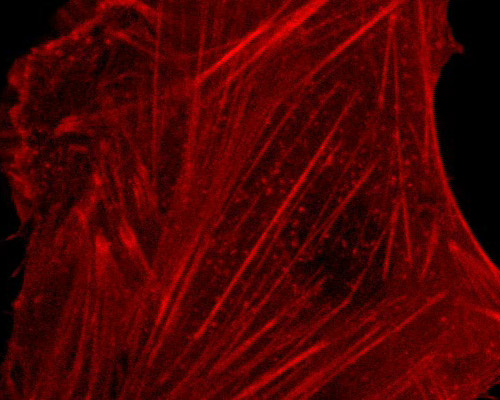Grey Fox Lung Cells with mRuby-Actin

The structure of the lung is called a "respiratory tree," with up to 28 levels stemming between the trachea and the alveolus. The inner segment of the lungs is where actual gas exchange between the blood and the external environment takes place. Capillaries permit simple diffusion around alveoli, which increase the surface area of the lungs with a characteristic four-liter volume. Carbon dioxide-rich blood enters by the pulmonary veins and penetrates the alveolar capillaries. When the waste carbon dioxide is freed, the hemoglobin in the red blood cells is then able to bind oxygen from the new air breathed in.
The actin cytoskeletal component was explored in this digital video sequence featuring cultured fox lung fibroblasts (FoLu line). The cells are shown expressing mRuby fused to the protein actin. Cytoskeletal actin filaments work in conjunction with intermediate filaments and microtubules to provide structure to the cell, protect its contents, facilitate movement, enable division, and assist in transport and signal transduction. Filamentous actin is concentrated just beneath the plasma membrane.
The featured fox lung cells are expressing mRuby fused to actin. Developed through mutagenesis, mRuby is a monomeric variant of eqFP611, a fluorescent protein initially isolated from the bubble-tip anemone (Entacmaea quadricolor). mRuby features 29 mutations not present in its parent protein. The red fluorescent protein exhibits peak excitation and emission at 558 nanometers and 605 nanometers.



